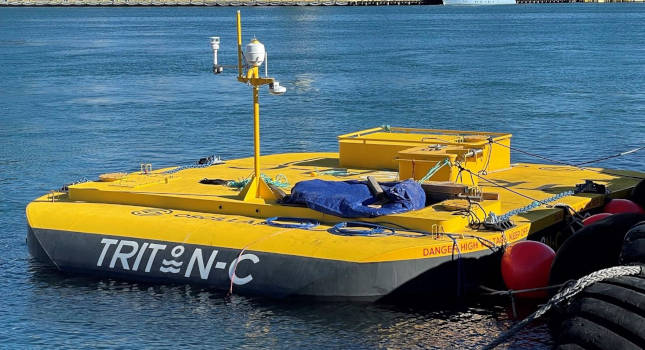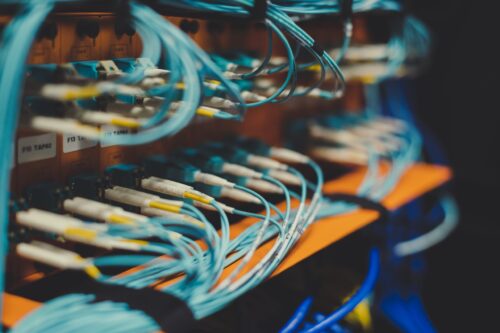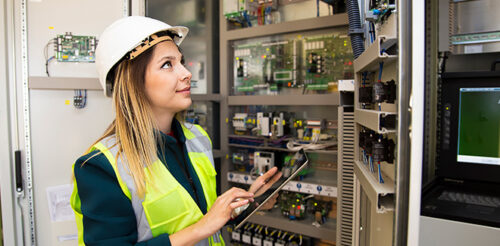Five control system design challenges for developing wave energy converter
Wave energy has a lot of potential for renewable energy, but developing a sustainable and efficient project for a power company had several challenges that needed to be overcome.
Control system insights
- Oscilla Power wanted a wave energy converter that could eliminate energy capture and conversion inefficiencies.
- They faced several challenges such as reliable operation in a remote maritime environment and maximizing energy efficiency.
The Earth’s oceans have untapped potential to serve as a source of renewable energy. When combined with wind and solar, wave energy will make it possible to truly provide 24/7 renewable energy. Oscilla Power set out to develop a sustainable and reliable wave energy converter (WEC) that could economically tap into this resource.
Oscilla did not just want to create a WEC that could convert waves to electricity. Instead, they wanted their prototype, the Triton-C, to eliminate energy capture and conversion inefficiencies present in the other WECs being tested so their system could be used for utility-scale energy production in the future. To do this, Oscilla Power decided to incorporate a multi-mode point absorber and three independent hydrostatic, hydraulic drivetrains. Through in-lab prototypes, they knew this design would increase energy capture from ocean waves by extracting energy through all six degrees of freedom on the float. They also determined having three independent drivetrains would provide a reliable, flexible, and high-efficiency method for converting the oscillating mechanical energy of the ocean waves to electricity.
This design, coupled with the harsh maritime environment and the inherent space and weight limitations of operating on a float, presented several very complicated control problems that Oscilla Power needed to solve before they could bring their prototype out of the lab. As they planned for this first non-lab prototype of the Triton-C, they approached Applied Control Engineering (ACE) to discuss their unique combination of control and communication challenges.
First, to maximize wave energy capture, the WEC needed to autonomously coordinate a significant amount of data from multiple sources. Second, to optimize power generation, the WEC needed a tight control loop that could communicate wave condition data and adjust the generator motors. Third, they needed a reliable on-board network that would protect the process systems while allowing for interoperation with a variety of third-party devices and redundant communication paths to the shore. Finally, since this would be the first large-scale prototype for Oscilla Power, capturing high-quality and accurate data to prove this model was crucial. There were five challenges that needed to be overcome during the project’s development.
Challenge 1: Operating in a remote maritime environment
Beyond ensuring the selected control equipment could perform the required advanced control functionality, the integrator had to first determine if the equipment could meet the challenges of functioning autonomously on a float in a maritime environment. This meant the hardware had to be rugged enough to handle environmental challenges such as salt water and high temperatures and humidity while also being compact enough to fit within the tight space on the float and not add a lot of weight.
To address these needs and perform the required advanced control functionality, the companies selected a hardware platform that included a programmable logic controller (PLC), industrial PC and human-machine interface (HMI).
To help with space and weight requirements, the integrator selected a small-profile NEMA 4X design for the main control cabinet and three drivetrain remote I/O cabinets as shown in Figure 1.

Figure 1: The image on the left shows the main control cabinet and the image on the right shows one of the drivetrain cabinets. Courtesy: Applied Control Engineering, Inc.
The decision was made to house the main controller and three drivetrain controllers separately to cut down on the amount of wiring needed throughout the float, reducing the overall weight of the control system. To secure the system and protect it from being tampered with while operating autonomously in the ocean, all the cabinets were equipped with security locks and Power over Ethernet (POE) security cameras.
Challenge 2: Maximizing wave energy efficiency
Oscilla Power’s goal was to make large-scale wave energy production possible by maximizing the energy produced by incoming waves. To do this, advanced calculations were needed so the control system could determine the ideal torque required for the generators. For this functionality, Oscilla selected a real-time hardware simulation system. Some of the information the system needed to make its calculations is available in the local control system. However, data about the weather in the region and wave conditions is only available from internet-based sources.
The integrator developed a series of custom Python scripts to collect this information and push it to the local control system and the simulation system. The advanced algorithm within the simulation system consumes this data and calculates the most efficient torque for the generator, which is in turn collected by the PLC and then provided to the motion control center (MCC) to adjust the generator demand torque.
Challenge 3: Performing secure communication across multiple unique platforms
The WEC has numerous onboard systems with which the PLC must communicate and because these systems are unmanned, the team needs to be able to monitor all aspects of the prototype at any time. Data from onboard systems are concentrated into the PLC and visualized locally (Figure 2).

Figure 2: A Screenshot of the Local WinCC HMI. Courtesy: Applied Control Engineering, Inc.
This interface is available to the team using a remote desktop over a fiber communication cable that runs from the shore out to the control system or the backup cellular connection. The control system also provides notifications to the prototype team via text or email messages from the locally-installed application when abnormal conditions occur on the float. These conditions include the position of the float, high wind, and the general movement of the float.
Onboard the float, there are multiple communication protocols that had to be accommodated to collect information from the various subsystems needed for the operation of the WEC. The PLC control system, drivetrain, and generator control cabinet were all based on one manufacturer’s technology and could therefore communicate over a Profinet in a fault-tolerant ring. However, the other systems on the float required several additional communication gateways to interface with the control system.
A Modbus gateway was set up to interact with several onboard systems as well as the onshore power distribution systems. The systems on the float include the bi-directional communication with the simulator referenced above and the battery management system that sustains the control system using a small portion of power collect from the waves. Data from the onshore power distribution systems are also monitored by the PLC. This includes an automatic transfer switch (ATS), an electric meter and the power management systems.
A CANbus gateway was configured to monitor the primary capacitor bank that helps condition the power delivered to the shore, as well as the onboard GPS that is crucial to knowing that the float is staying in the place it is expected to be.
Securing the communications was a top priority in the design of the prototype. Most of the system including the fiber connection back to the shore is on a closed infrastructure, yet the use of a backup cellular network meant that outside threats to the onboard systems needed some additional consideration.
The network is segmented into three virtual local area networks (VLANs): The control system, switch administration and onboard cameras. These VLANs are protected behind a firewall that only permits the traffic necessary for the operation of the WEC. Access into the WEC networks is secured using a virtual private network (VPN) managed by the firewall device.

Figure 3: A dashboard showing historical and real-time data from the WEC. Courtesy: Applied Control Engineering, Inc.
Challenge 4: High-speed data collection and reporting
Data collection, especially in the prototype phase, is crucial to proving the technology is viable in an ocean environment. The data collected could lead to operational changes and future enhancements that would be used as this technology moves towards large scale deployment. As part of this system the specification asked for a rate of collection up to 10ms for the onboard instrumentation. This data then needed to be contextualized and presented to the research team involved with the prototype.
The integrator set up a separate virtual historian server on the onboard computer to collect and host the data. Historian software was selected to collect the required data at the required rates. The software also had a module that allowed the integrator to develop public- and private-facing dashboards (Figure 3) so the research team could see the data they needed to monitor the WEC and the general public could see the WEC’s performance in the field. Figure 3 shows an example of the dashboard being developed.
Challenge 5: Implementing and testing a complex prototype during a global pandemic
Since the culmination of this work happened at the height of the COVID-19 pandemic, the integrator needed to develop a creative method for conducting a factory acceptance test (FAT) that eliminated travel and face-to-face contact. Remote FAT execution relied on video and screen sharing to execute a fully-witnessed test protocol with participants located on opposite sides of North America. These technologies are still used today to make changes to the system as it prepares for launch and goes through its year-long test in the Pacific Ocean.
Successfully moving from small-scale tank testing to full-scale prototype deployment
The integrator met Oscilla’s requirements for performing remote control, data sampling, communication, and advanced operational tasks in a compact control system. As a result, highly efficient energy capture from all wave-driven motions with Oscilla’s advanced hydraulic drivetrain design and efficient energy conversion with low electrical power variability is possible in the Triton-C prototype.
Throughout this multi-phase design and deployment, the two companies built a partnership collaborating on all aspects of the design including identifying the appropriate control system platform, development of a design specification and implementing a control system that provides reliable performance in a harsh environment.
The integrator continues to provide remote support and help ensure this WEC technology is well-positioned to deliver cost-competitive, utility-scale energy that can complement existing renewables and help reduce society’s reliance on fossil fuels.
Chris Hudson is lead project engineer at Applied Control Engineering, Inc. Applied Control Engineering, Inc., is a member of the Control System Integrators Association (CSIA). Edited by Chris Vavra, web content manager, CFE Media and Technology, cvavra@cfemedia.com.
Do you have experience and expertise with the topics mentioned in this content? You should consider contributing to our CFE Media editorial team and getting the recognition you and your company deserve. Click here to start this process.







